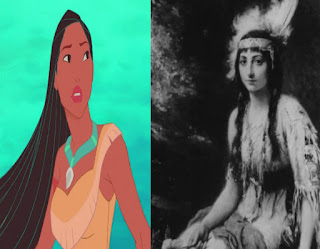Many tales have been told about Pocahontas, but not all of them are true.
Pocahontas has been romanticized throughout American history, thanks in no small part to the accounts of English settlers John Smith and John Rolfe, and of course, the 1995 Disney animated movie. But who was the real Pocahontas?
To help dispel the many myths surrounding the popular Native American figure, here are some facts that originate from Native American oral history and contemporary historical accounts.
Pocahontas was actually her nickname
Born around 1596, Pocahontas was actually known as Amonute, and to those closest to her, Matoaka. The name Pocahontas, in fact, belonged to her mother, who died while giving birth to her.
Also read:
- Meet Madeleine McCann, the inspiration behind Telemundo's Where Is Elisa? and The Search For Frida
- The suicide anthem Gloomy Sunday
Devastated by his wife's death, Pocahontas' father, Chief Powhatan Wahunseneca of the Pamunkey tribe of Virginia, called his little daughter Pocahontas as a nickname, which meant "playful one" or "ill-behaved child."
A spirited young girl who liked to do cartwheels, Pocahontas grew up to be a brave and intelligent leader and translator on behalf of her people.
There was no romance between Pocahontas and John Smith
By the time 27-year-old Smith and the rest of the English colonists arrived on Native American lands in 1607, Pocahontas was probably around 10 years old. Despite Smith embellishing the idea of a romance between them in order to sell books that he'd later author, they were never involved.
What is true is that Smith spent a few months with Pocahontas' tribe as a captive, and while there, he and Pocahontas taught each other basic aspects of their respective language.
Pocahontas would later marry Indian warrior Kocoum at age 14 and shortly give birth to their son "little Kocoum."
Also read:
- Murder of Dee Dee Blanchard - the woman who drugged and confined her daughter to a wheelchair
Pocahontas didn't warn Smith of a planned assassination against him
While Smith was being held prisoner, Chief Powhatan grew to trust him. In 1607 the chief decided to offer Smith a "werowance" role, which was the tribe's way of acknowledging him as an official leader of the colonies, giving him access to coveted resources such as food and better land.
Smith would later allege that while he trained to become a werowance, Pocahontas warned him of a deadly plot against him, and thus, saved his life. However, contemporary accounts show that if a Native American chief was honoring a man, there would be no threat to his life.
Additionally, children were forbidden to attend a werowance ceremony, so Pocahontas wouldn't have been present.
Pocahontas was not traded to the English; she was kidnapped and raped
With tensions rising between the Powhatan and the English, rumors spread that Pocahontas was a prime target for kidnapping. Hoping to prevent future attacks by Native Americans, English Captain Samuel Argall made those rumors a reality and took the Chief's beloved daughter away with him after threatening violence against her village.
Before leaving, Argall offered a copper pot to the tribe and later claimed the two parties had made a trade. Forced to leave her husband and small son, Pocahontas boarded an English ship, not knowing that colonists had murdered her husband Kocoum shortly after.
While captive in Jamestown, Pocahontas was raped by possibly more than one colonist — an act that was incomprehensible to Native Americans. She grew into a deep depression and had a second son out of wedlock. That son would be named Thomas Rolfe, whose biological father may have actually been Sir Thomas Dale.
Pocahontas was not an eager goodwill ambassador of the New World
The story of Pocahontas marrying tobacco planter Rolfe for love is highly unlikely, especially considering Rolfe was under great financial pressure to somehow forge an alliance with the Powhatan to learn their secret tobacco curing techniques.
In the end, he decided the best way to win over the Powhatan was to marry Pocahontas, who all the while was being forced to wear English clothes, convert to Christianity and adopt the name, Rebecca.
Out of fear of being kidnapped himself, Chief Powhatan didn't attend Rolfe and Pocahontas' wedding ceremony and instead, offered a pearl necklace as a gift. He'd never see his daughter again.
To help further fund the tobacco business in the colonies, Rolfe took Pocahontas and son Thomas with him to England to show the court the "goodwill" between the colonists and Native Americans. Thus, Pocahontas was used as a prop, paraded around as an Indian princess who embraced western culture.
Although she was considered in good health right before leaving England, Pocahontas suddenly fell ill and died after dining with Rolfe and Argall, the man who kidnapped her. The tribesmen who accompanied Pocahontas on the trip believed she was poisoned.
At the time of her death, Pocahontas was around 21 years of age. She was buried in Gravesend, England at Saint George’s Church on March 21, 1617. The location of her remains is unknown.
You can also find me through the other platforms by pressing this link in brackets and if you're struggling to share the article through certain platforms use this link (Lnk.Bio).



No comments:
Post a Comment